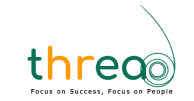
Productivity tracking tools have become an essential part of modern work environments, helping individuals and teams manage tasks, optimize schedules, and collaborate more efficiently. These tools can be particularly beneficial for HR teams, who often juggle multiple tasks and deadlines while working to improve employee engagement and retention. In this blog post, we will explore the benefits of productivity tracking tools for HR teams, and how they can complement an existing SaaS HR platform.
Here are lists of available online tools you can use:
- Trello: A visual collaboration and task management tool that allows users to organize and prioritize tasks in a flexible and intuitive way.
- Asana: A project and task management tool that allows teams to track and manage their work more efficiently.
- RescueTime: A time tracking tool that helps users understand their digital habits and optimize their productivity.
- Todoist: A task management tool that allows users to create and manage tasks, set reminders, and prioritize their work.
- Pomodoro Timer: A productivity technique that involves breaking work down into 25-minute intervals with 5-minute breaks in between. The Pomodoro Timer app helps users apply this technique and stay focused on their work.
- Focus@Will: A music streaming service that provides background music specifically designed to help users focus and increase productivity.
- Evernote: A note-taking and productivity tool that allows users to capture and organize ideas, tasks, and notes in a single location.
- Google Keep: A note-taking app that allows users to create, organize, and share notes, reminders, and to-do lists.
- Forest: A unique productivity app that uses gamification to help users stay focused on their work. Users “plant” a virtual tree and must avoid using their phone for a designated period of time in order for the tree to grow.
- Habitica: A productivity app that turns your to-do list into a role-playing game. Users can earn points and rewards for completing tasks and develop new habits.
Benefits of Productivity Tracking Tools for HR Teams
- Better Task Management: HR teams are often responsible for managing multiple tasks simultaneously, including recruitment, onboarding, payroll, and performance management. Productivity tracking tools like Trello, Asana, and Todoist provide a comprehensive view of the tasks at hand, their progress, and deadlines. This helps HR teams allocate and manage tasks more efficiently, reducing bottlenecks and ensuring timely completion of projects.
- Improved Time Management: Time tracking tools like RescueTime and Pomodoro Timer help HR teams identify time-wasting activities and optimize their work schedules to improve productivity. A study by Robert Half found that interruptions and distractions can reduce productivity by up to 40%, making time management a crucial factor for HR teams. By tracking their time and optimizing their work schedules, HR teams can work more efficiently and meet their deadlines.
- Enhanced Collaboration: Collaboration is essential for HR teams, who often work closely with other departments and external stakeholders. Productivity tracking tools facilitate collaboration among team members, enabling them to share ideas, files, and feedback in real-time. This can help HR teams work more efficiently and collaborate on tasks such as recruitment, performance management, and employee engagement.
- Better Insights: Productivity tracking tools provide valuable insights into team performance, individual productivity, and resource allocation. These insights can help HR teams identify areas of improvement, set goals, and optimize workflows. For example, a study by LinkedIn found that the most successful recruiting teams are those that regularly review their data and metrics to improve their processes.
- Integration with SaaS HR Platforms: Most productivity tracking tools can integrate seamlessly with SaaS HR platforms, such as tHRead, BambooHR, ADP, and Zenefits. This can provide HR teams with a centralized dashboard to manage HR processes, including recruitment, onboarding, payroll, and performance management. By integrating productivity tracking tools with an existing SaaS HR platform, HR teams can streamline their processes, reduce manual work, and improve their operational efficiency.
Conclusion and References
Productivity tracking tools can be a powerful tool for HR teams, helping them manage tasks, optimize schedules, and collaborate more efficiently. By integrating these tools with an existing SaaS HR platform, HR teams can streamline their processes, gain valuable insights into their work processes, and improve their operational efficiency. To learn more about the benefits of productivity tracking tools for HR teams, we recommend the following references:
- Robert Half. “Interruptions and Distractions Are Eating Up Your Workday.” https://www.roberthalf.com/blog/management-tips/interruptions-and-distractions-are-eating-up-your-workday.
- LinkedIn. “Global Recruiting Trends 2018.” https://business.linkedin.com/content/dam/business/talent-solutions/global/en_us/c/pdfs/Global_Recruiting_Trends_2018_US.pdf.
- BambooHR. “Productivity Hacks for HR.” https://www.bamboohr.com/blog/productivity-hacks-for-hr/.
ADP. “How to Optimize HR Productivity with Technology.” https://www.adp.com/what



